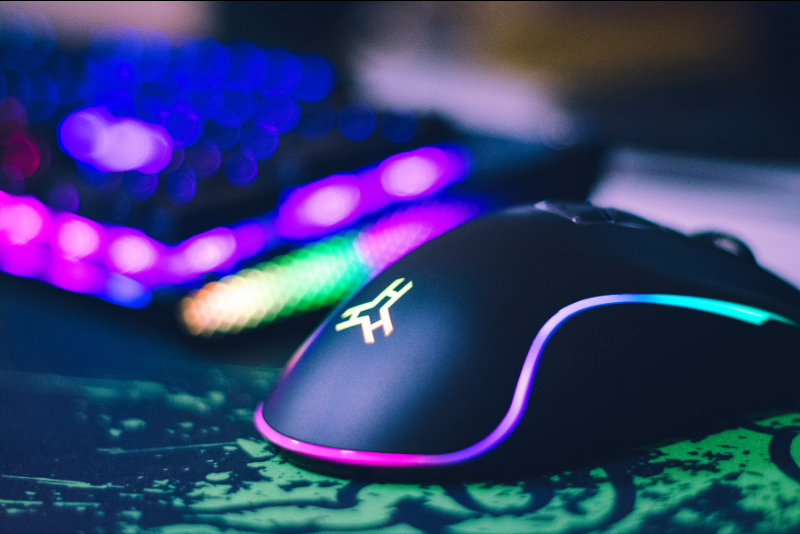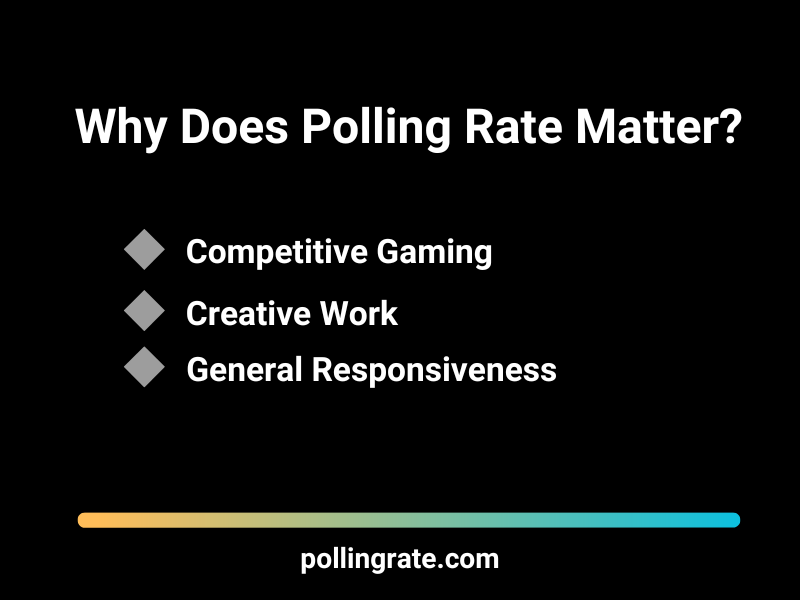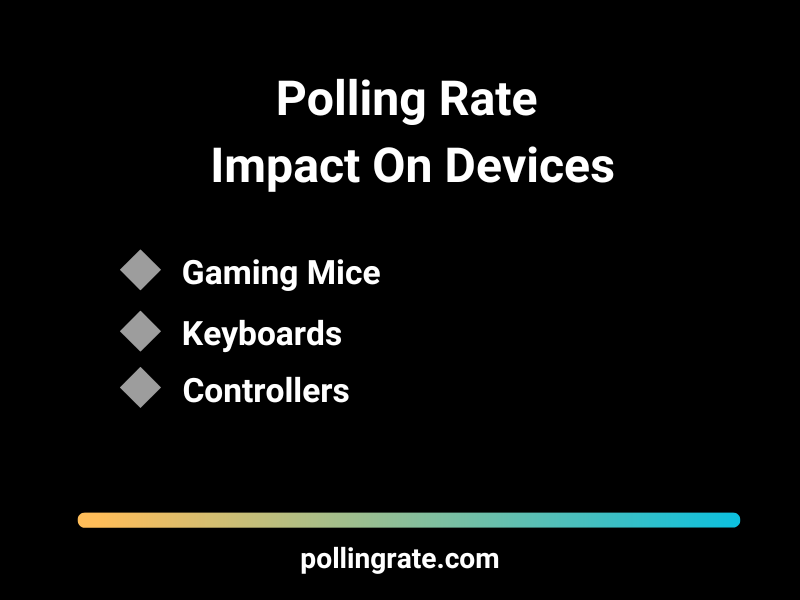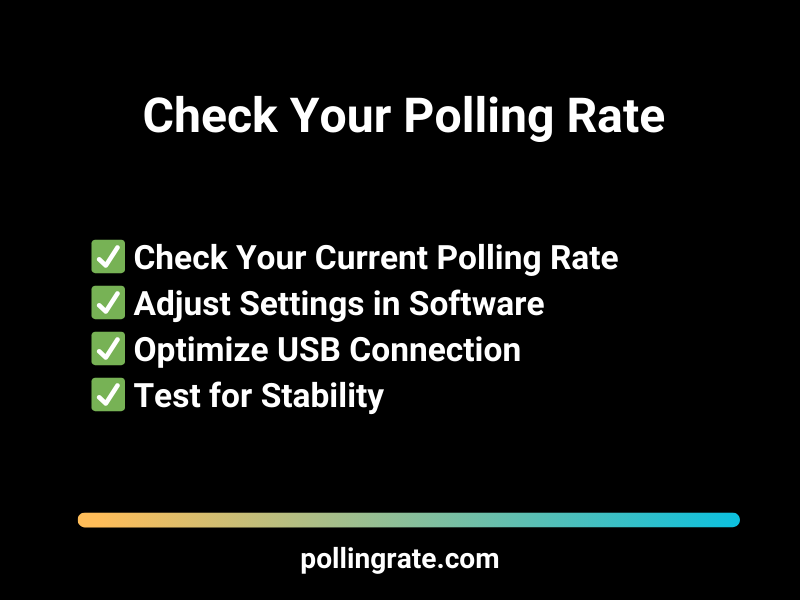What is Polling Rate? – Understanding Polling Rate in Gaming and Performance 2025
What is polling rate and why is it important for your gaming or work performance? Polling rate is a crucial factor in determining how responsive your mouse or keyboard feels during use.
In simple terms, polling rate refers to how often an input device—such as a mouse or keyboard—sends data (like movement or keystrokes) to your computer. It is measured in Hertz (Hz). For example, a polling rate of 1000 Hz means the device reports its position or input 1,000 times per second.
A higher polling rate can significantly reduce input lag, leading to smoother cursor movement and faster reaction times. This makes it especially valuable for gamers, designers, and anyone who relies on high-speed accuracy.
Why Is a High Polling Rate Important?
Reduced input delay: Helps your device respond faster to your actions.
Smoother performance: Improves tracking and accuracy, especially in fast-paced environments.
Better user experience: Whether you’re gaming or working, everything feels more responsive.
If you’re shopping for peripherals or optimizing your setup, understanding what is polling rate can help you make smarter choices and enhance your overall performance.
For example:
125Hz = Updates every 8 milliseconds
500Hz = Updates every 2 milliseconds
1000Hz = Updates every 1 millisecond
2000Hz = Updates every 0.5 milliseconds
A higher polling rate generally means faster input recognition, which is especially beneficial in fast-paced gaming or professional creative work where precision is key.
Tip: Ready to level up your competitive gaming? Don’t miss our top pick on Amazon* (Affiliate Link)!

What is Polling Rate and Why Does It Matter?
nderstanding what is polling rate is essential if you want to improve responsiveness and reduce input lag on your devices. A high polling rate means your mouse or keyboard sends updates to your computer more frequently—often hundreds or thousands of times per second. This can dramatically enhance user experience in various scenarios.
A higher polling rate reduces input lag and improves responsiveness, making movements and clicks register faster. This is particularly important for:
✅ Competitive Gaming
In fast-paced games, every millisecond counts. A higher polling rate ensures minimal delay between your hand movements and on-screen actions, giving you a crucial edge over opponents.
✅ Creative Work
Graphic designers, video editors, and digital artists benefit from real-time precision when using drawing tablets and other peripherals. A high polling rate ensures smoother lines and more accurate input.
✅ General Responsiveness
Even for everyday tasks like browsing or office work, a higher polling rate can make your system feel significantly more fluid and responsive.

Tip: If you’re asking yourself what is polling rate and whether it matters for your setup—the answer is yes, especially if performance and precision are important to you.
How Polling Rate Affects Different Devices
Polling rate impacts various types of devices differently. Here’s how:
🎮 Gaming Mice: Higher polling rates improve precision and tracking, ensuring minimal latency in fast-paced games. Most gaming mice support at least 500Hz, with premium models offering 1000Hz or more.
⌨️ Keyboards: Mechanical and gaming keyboards often have a higher polling rate (e.g., 1000Hz) to register keypresses faster, which is essential for competitive gaming and rapid input sequences.
🖥️ Controllers & Consoles: Some gaming controllers support higher polling rates when connected via USB to reduce input lag, providing a smoother gaming experience.

Is a Higher Polling Rate Always Better?
If you’re wondering what is polling rate and whether higher values are always better, it’s important to consider not just the benefits but also the potential drawbacks. While a high polling rate can significantly improve responsiveness, it does come with a few trade-offs:
⚠️ Increased CPU Usage
A polling rate of 1000Hz sends data to your computer 1000 times per second, which requires more processing power compared to lower rates like 125Hz. Modern CPUs generally handle this without issue, but entry-level or older systems may experience slight performance impacts.
📉 Diminishing Returns
Yes, there’s a noticeable improvement going from 125Hz to 500Hz or 1000Hz. However, beyond 1000Hz, most users won’t see a major difference in real-world performance. The benefits start to level off, especially for casual users.
🔌 Compatibility Issues
Some older USB ports may not supply stable power at extremely high polling rates. Additionally, a few games and software applications might not fully support polling rates above 1000Hz, leading to inconsistent behavior or performance drops.
What Is Polling Rate – How to Test and Optimize It
If you’re trying to figure out what is polling rate and how to get the best performance from your mouse or keyboard, proper testing and optimization are key. Follow these steps to fine-tune your setup and ensure maximum responsiveness:
Check Your Current Polling Rate: Use an online polling rate tester or software from your device manufacturer.
Adjust Settings in Software: Many gaming mice and keyboards come with customization software that allows you to change polling rates.
Optimize USB Connection: Ensure your device is connected to a USB 3.0 port for maximum stability and power delivery.
Test for Stability: Some systems may struggle to maintain ultra-high polling rates. Test in-game or through diagnostic software to ensure smooth operation.

Measuring Input Lag: Understanding Latency in Milliseconds (ms)
If you want to determine your current polling rate, there are several ways to measure it accurately. Here’s how:
🔍 Online Polling Rate Testers: Websites like “Mouse Rate Checker” allow you to test your mouse’s polling rate by moving it and observing real-time updates.
🛠 Manufacturer Software: Many gaming brands provide dedicated software (such as Logitech G Hub, Razer Synapse, or SteelSeries Engine) that display and allow adjustments to your device’s polling rate.
💻 Third-Party Applications: Programs like “DXTweak” or “MouseTester” provide detailed insights into polling rate stability and consistency.
📊 Manual Testing: Some users prefer using FPS counters and frame-time analysis in games to detect input latency changes when switching polling rates.
For best results, test your polling rate multiple times to ensure accuracy, and always use a stable USB connection for consistent readings.
| Polling Rate | Update Interval | Performance |
|---|---|---|
| 1000Hz - 2000Hz | 1ms - 0.5ms | 🏆 Ideal for competitive gaming |
| 500Hz | 2ms | ⚡ Smooth experience for most users |
| 125Hz | 8ms | 🐢 Noticeable lag, not recommended for gaming |
Speed Wins Games: What is Polling Rate and Why it Matters in Competitive Gaming
In the world of high-stakes gaming, every millisecond counts. Your gear’s polling rate—how often your device reports input to your PC—can be the difference between a clutch win and a missed opportunity. A higher polling rate means faster communication between your gear and your system, resulting in smoother aim, quicker builds, and more responsive gameplay.
Understanding and optimizing what is polling rate is one of the easiest ways to enhance your competitive performance without upgrading your entire setup.
🔥 Top Gaming Gear with Ultra-High Polling Rates 🔥
🖱️ Razer DeathAdder Elite Gaming – on Amazon* (Affiliate Link)
A classic among competitive players, the DeathAdder Elite features a 1000Hz polling rate for ultra-smooth responsiveness. Combined with a high-precision 16,000 DPI optical sensor and Razer’s signature ergonomic design, it’s perfect for long gaming sessions and deadly accurate shots.
⌨️ Razer Huntsman V3 Pro Mini Gaming Keyboard – on Amazon* (Affiliate Link)
Compact and built for speed, this 60% keyboard features Rapid Trigger Optical Switches and a 1000Hz polling rate. Every keystroke is registered instantly, perfect for fast-paced inputs in games like Valorant, Fortnite, or CS2.
📺 Acer XV272U 27″ WQHD 240Hz IPS Gaming Monitor – on Amazon* (Affiliate Link)
With a 240Hz refresh rate, 0.5ms response time, and AMD FreeSync Premium, this monitor delivers super-smooth visuals with crisp motion clarity. Pair it with high polling rate peripherals for a complete low-latency experience that helps you stay ahead in every firefight.
🖱️ Razer Viper V3 Pro Wireless (8000Hz) – on Amazon* (Affiliate Link)
Want the fastest wireless mouse on the market? The Viper V3 Pro supports up to 8000Hz polling rate via HyperPolling Wireless Dongle (sold separately). Ultra-lightweight, esports-grade, and used by top-tier pro players—this is for gamers who demand no compromises.
🎮 Why Polling Rate Is a Game Changer
A standard 1000Hz device polls every 1ms. But with 8000Hz mice or optimized 1000Hz keyboards and monitors that support ultra-high refresh, you reduce latency dramatically. This means more responsive movement, faster edits, and better aim tracking—especially in fast-paced games.
What Is Polling Rate – Common Myths Debunked
When searching what is polling rate, you’ll likely come across a lot of claims—some true, others misleading. While polling rate does impact responsiveness, it’s important to separate fact from fiction. Here are three common myths about polling rate and the truth behind them:
🚫 Myth: Higher Polling Rate Always Equals Better Performance
While higher polling rates can reduce latency, the difference is often negligible for casual users. It’s competitive gamers and professionals who benefit most from polling rates of 1000Hz or higher. For regular web browsing or office work, the performance gain may not be noticeable.
🚫 Myth: 2000Hz Polling Rate Is Always Superior to 1000Hz
Once you go beyond 1000Hz, the performance improvements start to diminish. In many cases, a 2000Hz polling rate won’t deliver a noticeably better experience—and some systems may not even support it reliably. A stable 1000Hz is often the sweet spot for most users.
🚫 Myth: Polling Rate Is the Only Factor Affecting Input Delay
If you’re researching what is polling rate to reduce input lag, remember: polling rate is just one piece of the puzzle. Sensor quality, DPI settings, USB polling stability, and even the software you’re using all contribute to how responsive your device feels.
Final Thoughts – What is Polling Rate?
What is polling rate, and why should gamers and performance-focused users care? Polling rate is one of those behind-the-scenes settings that can dramatically impact how responsive and fluid your setup feels—especially in competitive gaming scenarios.
Polling rate determines how often your mouse or keyboard reports its position or input to your system, measured in Hertz (Hz). In fast-paced games like Valorant, CS2, or Fortnite, even the slightest input lag can disrupt your timing, throw off your aim, and affect your performance.
At pollingrate.com, we’ve tested and seen how dialing in the right polling rate can:
Sharpen response times
Improve aim consistency
Eliminate subtle input delays
But it’s not just about choosing the highest number. Going too high on the wrong setup can lead to instability, CPU strain, or diminishing returns. Finding the optimal polling rate for your specific hardware is key to getting the best experience.
Whether you’re gaming competitively or just want a snappier feel in daily tasks, understanding what is polling rate and how to fine-tune it can give you a real edge.
👉 Want to get it right? Check out our full guide and make sure your inputs are always one step ahead.
